Hofstede’s Cultural Dimensions
Hofstede’s cultural values provide a framework that describes the effects of culture on the values of its members, and how these values relate to behavior. Hofstede’s work is a major resource in fields like cross-cultural psychology, international management, and cross-cultural communication.
Hofstede conducted a large survey (1967-1973) that examined value differences across the divisions of IBM, a multinational corporation. Data were collected from 117,000 employees from 50 countries across 3 regions. Using factor analysis, a statistical method, Hofstede initially identified four value dimensions (Individualist/Collectivist, Power Distance, Uncertainty Avoidance, and Masculinity/Femininity). Additional research that used a Chinese developed tool identified a fifth dimension: Long Term/Short Term orientation (Bond, 1991) and a replication, conducted across 93 separate countries, confirmed the existence of the five dimensions and identified a sixth known as Indulgence/Restraint (Minkov, 2010). In 2023 the Masculinity and Femininity dimension was renamed the Motivation toward Achievement and Success dimension to reflect changes in our understanding that gender is not binary and to clarify that the dimension does not solely measure gender roles.
The five values are discussed in detail below.
Motivation Towards Achievement and Success (task orientation/person orientation) refers to the distribution of emotional roles between the genders. High motivation cultures value competitiveness, assertiveness, material success, ambition, and power. Low motivation cultures place more value on relationships, quality of life and greater concern for marginalized groups (e.g., homeless, persons with disabilities, refugees). In high motivation cultures differences in gender roles are very dramatic and much less fluid than those in low motivation cultures where women and men share the same values that emphasize modesty and caring. High masculine cultures are also more likely to have strong opinions about what constitutes men’s work versus women’s work, while societies low on the motivation dimension permit much greater overlap in social and work roles of men and women.
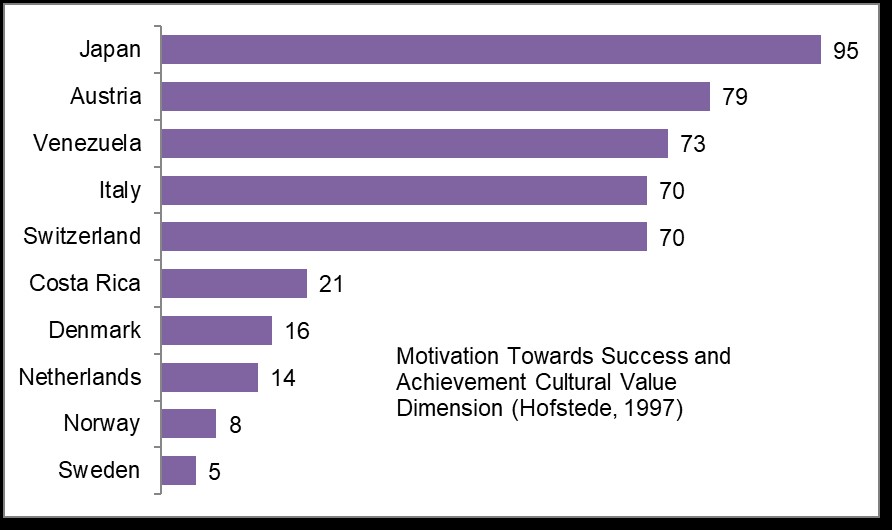
Uncertainty Avoidance (UA) addresses a society’s tolerance for uncertainty and ambiguity. It reflects the extent to which members of a society attempt to cope with anxiety by minimizing uncertainty. Another, more simplified, way to think about UA is how threatening change is to a culture. People in cultures with high UA tend to be more emotional, try to minimize the unknown and unusual circumstances and proceed with carefully planned steps and rules, laws and regulations. Low UA cultures accept and feel comfortable in unstructured situations or changeable environments and try to have as few rules as possible. People in these cultures tend to be more tolerant of change. Students from countries with low uncertainty avoidance don’t mind it when a teacher says, “I don’t know.”
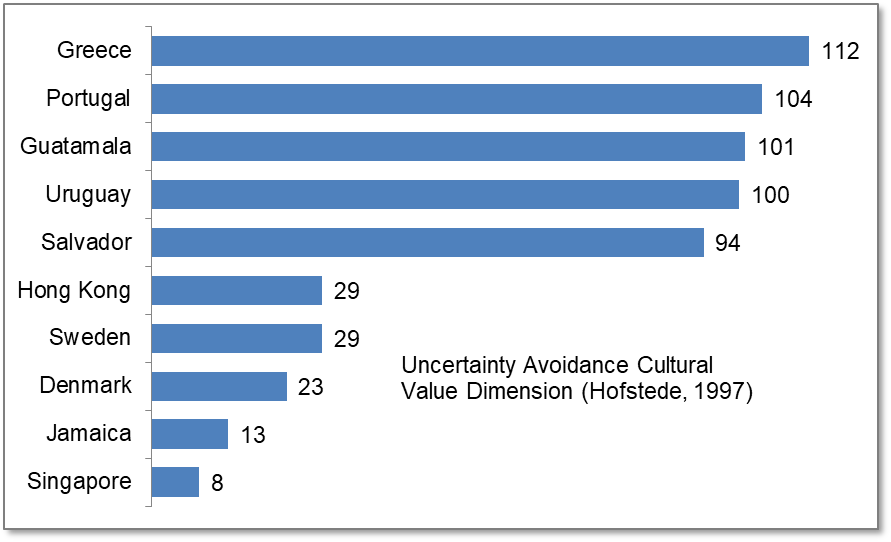
Power Distance (strength of social hierarchy) refers to the extent to which the less powerful members of organizations and institutions (like a family) accept and expect that power is distributed unequally. There is a certain degree of inequality in all societies, notes Hofstede; however, there is relatively more equality in some societies than in others. Individuals in societies that exhibit a high degree of power distance accept hierarchies to which everyone has a place without the need for justification. Societies with low power distance seek to have an equal distribution of power. Cultures that endorse low power distance expect and accept relations that are more consultative or democratic – we call this egalitarian.
Countries with lower PD values tend to be more egalitarian. For instance, there is more equality between parents and children with parents more likely to accept it if children argue with them, or “talk back” to use a common expression. In the workplace, bosses are more likely to ask employees for input, and in fact, subordinates expect to be consulted. On the other hand, in countries with high power distance, parents expect children to obey without questioning. People of higher status may expect obvious displays of respect from subordinates. In the workplace, superiors and subordinates are not likely to see each other as equals, and it is assumed that bosses will make decisions without consulting employees. In general, status is more important in high power distance countries.
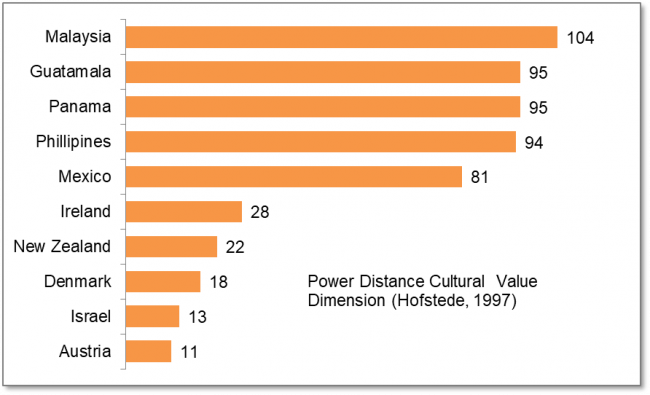
Individualist and Collectivism refers to the degree to which individuals are integrated into groups. Individualistic societies stress personal achievement and individual rights, focus on personal needs and those of immediate family. In individualistic societies, people choose their own affiliations and groups and move between different groups. On the other hand, collectivistic societies put more emphasis on the importance of relationships and loyalty. Individuals in collectivist societies belong to fewer groups and they are defined more by their membership in particular groups. Communication is more direct in individualistic societies but more indirect in collectivistic societies.
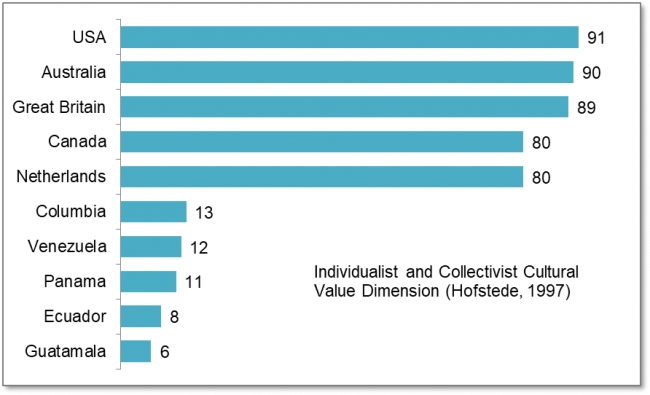
Long Term (LT) and Short Term (ST) describes a society’s time horizon; the degree to which cultures encourage delaying gratification or material, social, emotional needs of the members: LT places more importance on the future, pragmatic values, oriented toward rewards like persistence, thrift, saving, and capacity for adaptation. Short term values are related to the past and the present (not future) with emphasis on immediate needs, quick results, and unrestrained spending often in response to social or ecological pressure.
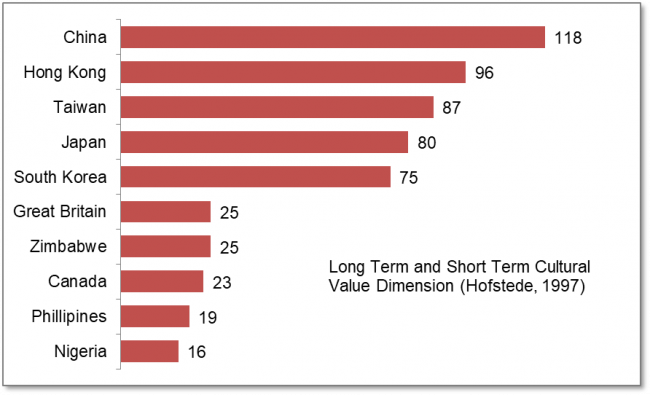
Considerations and Criticisms
The cultural value dimensions identified by Hofstede are useful ways to think about culture and to study cultural psychology; however, Hofstede’s theory has also been seriously questioned. Most of the criticism has been directed at the methodology of the study beginning with the original instrument. The questionnaire was not originally designed to measure culture but rather workplace satisfaction (Orr & Hauser, 2008) and many of the conclusions are based on a small number of responses (McSweeney, 2002). Although 117,000 questionnaires were administered, the results from 40 countries were used and only six countries had more than 1000 respondents. Critics also question the representativeness of the original sample.
The study was conducted using employees of a multinational corporation (IBM) who were highly educated, mostly male, who performed what we call ‘white collar’ work (McSweeney, 2002). Hofstede’s theory has also been criticized for promoting a largely static view of culture (Hamden-Turner & Trompenaars, 1997; Orr and Hauser, 2008) that does not respond to changes or influences of other cultures. It is hard to deny that the world has changed in dramatic ways since Hofstede’s research began.
Material and nonmaterial aspects of culture can vary subtly from region to region. As people travel, moving from different regions to entirely different parts of the world, certain material and nonmaterial aspects of culture become dramatically unfamiliar. As we interact with cultures other than our own, we become more aware of our own culture, which might otherwise be invisible to us, and to the differences and commonalities between our culture and others.

